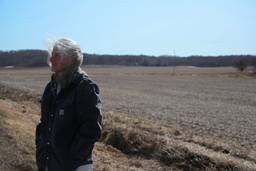
Words rise up to describe the work of a farmer caring for her land, her herd, her community. These words multiply, interbreed, compete and converge: the ecology of language.
Just as a word becomes recognizable to consumers, it’s often quickly snatched up by corporations and rendered meaningless. The word “green”, which arose in response to toxic chemicals and environmental degradation, was co-opted by Big Business and is now most often used as “greenwashing.”
“Sustainable” has likewise been absorbed. Oxymoronically, even Monsanto has entered the conversation. Monsanto claims:
“Our vision for sustainable agriculture strives to meet the needs of a growing population, to protect and preserve this planet we all call home, and to help improve lives everywhere. In 2008 Monsanto made a commitment to sustainable agriculture — pledging to produce more, conserve more and improve farmers’ lives by 2030.”
Terms like “natural” and “farm fresh” lack an agreed-upon definition and intentionally plaster food packaging with meaningless innuendo. Consumers without degrees in biology and chemistry are, many times, left struggling to understand what has been added to their meals.
A small number of claims on food packaging have an agreed-upon, sometimes legally restricted, definition — organic, free-range, grass-fed, cage-free, pasture-raised, non-GMO, Certified Humane, Animal Welfare Approved, and American Humane Certified. Those definitions are critical.
“Free-range,” for example, only means that the chicken had access to the outdoors, perhaps referring to one chicken-sized door in a barn housing 20,000 birds. Given airflow in large barns, that door may be sucking air in at a hurricane-like velocity, so that a chicken would never be willing to pass through it. But, in theory, those chickens could choose to go outside.
Cornucopia advocates for independent and transparent audits by third parties. Consumers should still be aware of precisely what has been investigated and what production methods are used.
Certified Humane and American Humane Certified labels offer no assurance of outdoor access for chickens. Similarly, the USDA grass-fed label now means only that cattle have access to pasture during the growing season (they could still be administered antibiotics, growth hormones, and feed on other than grass).
The American Grassfed Association label offers a higher level of assurance that animals are raised on pasture without growth hormones or antibiotics.
Cornucopia stands behind organics, advocating for those who believe in the spirit of organics to take back our movement from those who use its rhetoric to increase “organic” agribusiness-as-usual.
Although the standards have been weakened or, in some cases, circumvented by corporations, there are clear guidelines written into law to ensure that consumers are getting what they pay for.
Visit cornucopia.org for scorecards and news on how to find food worthy of your family’s table.
(This article was previously published in the spring issue of The Cultivator, Cornucopia’s quarterly newsletter.)

I hope you found this article important. Before you leave, I want to ask you to consider supporting our work with a donation. In These Times needs readers like you to help sustain our mission. We don’t depend on—or want—corporate advertising or deep-pocketed billionaires to fund our journalism. We’re supported by you, the reader, so we can focus on covering the issues that matter most to the progressive movement without fear or compromise.
Our work isn’t hidden behind a paywall because of people like you who support our journalism. We want to keep it that way. If you value the work we do and the movements we cover, please consider donating to In These Times.



